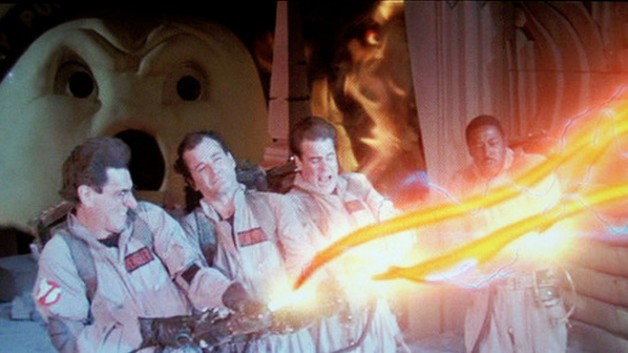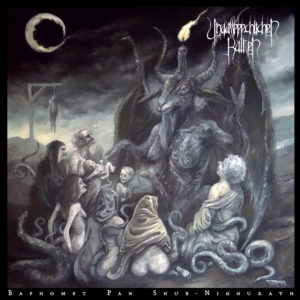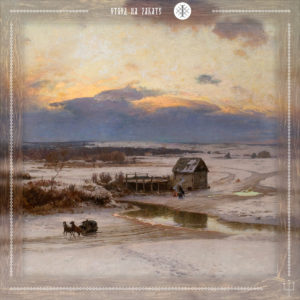We should probably discuss an unpopular relationship: how much of underground music, and wider 1980s and 1990s subculture, came from the unexceptional suburbs.
21 CommentsTags: glenn danzig, misfits, suburbia, underground music
We should probably discuss an unpopular relationship: how much of underground music, and wider 1980s and 1990s subculture, came from the unexceptional suburbs.
21 CommentsTags: glenn danzig, misfits, suburbia, underground music
Underground occult metal blog Praefuscus Ferrum recently posted a piece entitled “Underground turned Funderground, and the Obscurantist Elite” proposing that what killed underground metal was widespress consumer access to new technologies such as the internet. These and the increased exposure to fans led artistically successful underground metal bands to pursue raw consumerism at the expense of writing transcendent music. D.A.R.G. points out that “the truest artists purposefully hide away from the profane eye” as the communication mediums the underground metal utilized (physical mail, tape trading, and BBSes) have been usurped by ones more accessible to laymen. He states the underground became the “funderground” in the blink of an eye as mainstream rock and pop fans who felt adventurous wanted rock and pop music with “black” and “death” “metal” production aesthetics, not actual death, black, or even heavy metal. Now the musicians actually writing novel underground metal compositions hide unbeknownst to the typical beer metaller in plain sight.
11 CommentsTags: Black Metal, consumeriam, death metal, demoncy, desecresy, funderground, hidden metal, infamous, metal underground, praefuscus ferrum, sammath, Serpent Ascending, underground, underground metal, underground music, underground never dies
Right now, above the metal underground there is what was coined, I believe originally by Pogrom from Arghoslent, the “Funderground”. The funderground consists of independent labels, sometimes mainstream distributed, releasing thousands of albums each year full of rehashed material or rebranded three-chord hardcore with different superficial aesthetics to fuel a bar show audience’s drunken moshing or make hipsters feel smart for liking an indie rock release with a dirty production. One can see this divide in most of the popular “underground” web forums such as those of Nuclear War Now! and Full Moon Productions. The most popular “underground” “metal” releases of each year are all older metal rehashed into pop-rock structures or rebranded hardcore. This divide is similar to what is felt in mainstream Western culture with the leftist “elites”‘ constant Marxist virtue signaling and branding freethinkers with various epithets for refusing to chant the praises of socialism mandated by the vanguard party.
32 CommentsTags: ananku, best of, Black Metal, death metal, elitism, funderground, Godless Arrogance, Heavy Metal, hipster invasion, james hetfield, kaeck, metallica, sammath, Serpent Ascending, Stormkult, underground, underground metal, underground music

It’s official: according to a new year-end report released by Nielsen, over the course of 2016, streaming became the primary mode of music consumption in the U.S. Overall on-demand audio streams surpassed 251 billion in 2016 — a 76 percent increase that accounts for 38 percent of the entire music consumption market. Plus, “the on-demand audio streaming share [of total music consumption] has now surpassed total digital sales (digital albums + digital track equivalents) for the first time in history.”
Streaming is the public consciousness recognizing that most of what the mainstream music industry has to offer is disposable. The labels can’t even find or develop potentially good new talent anymore as due to gutting their artists and repertoire departments and what revenue they make flowing upwards towards executives and shareholders. Average consumers never possessed high-fidelity playback chains of dedicated gear to take full advantage of the compact disc and vinyl records anyway; they only had mediocre integrated receivers hooked up to poorly performing speakers and headphones. Furthermore everyone truly into underground or once underground music genres now digs deeper, purchasing releases with zero quality control which commonly have print runs of only a few hundred to a few thousand copies. Classical continues to do okay too as classical listeners still buy the physical album and tend to have marginally better equipment.
12 CommentsTags: music industry, music streaming, streaming, underground music

Article by David Rosales.
A trend in the modern conception of anything has been that the newer something else, the better we expect or assume it to be. Experience in reality, however, has also given rise to another perception: that the new tends to be worse and not better. Attempts at rationalizing this drive the pseudo-intellectual, pro-sheeple crowd to say that times just change, but ratios of quality do not vary. This is not only unscientific but an obvious politically correct answer that has as its premise that everyone is equal, and hence, that the resulting products of these “equal” people must also be probabilistically equal. Impermeable external influence seems to them the only changing factor, with the internal being either infinitely constant or practically negligible. This is assumed and then possible causes are haphazardly and desperately pieced together, the answer is assumed and then anything is either positive evidence or brushed aside if too problematic to incorporate into the fairy tale. Ignorance compounded with pretense and emotional insecurity always results in capricious imposition of an arbitrary and dogmatic concepts and scale of values.
29 CommentsTags: Bathory, hell awaits, slayer, Under the Sign of the Black Mark, underground, underground metal, underground music, underground never dies

Article by David Rosales.
Ancient myths are the remnants of an age when oral traditions were the main way by which humans preserved and passed on knowledge. This may be the reason why multi-layered symbols and complex relations in stories awkwardly designed to fit differing messages into a form that we may now consider silly. Differing schools of scholarship have developed distinct theories when compiling, reconstructing, and interpreting these messages. Many keep their own “updated” versions which have morphed on their own into the age of the text when the written word defined the transferring and preservation of human knowledge.
10 CommentsTags: crimson relic, Donald Alexander Mackenzie, Forbidden Rites, franz berwald, merciless, Mythology, mythos, Purgatory's Reign, Richard Kieckhefer, Serpent Ascending, The Awakening, The Enigma Unsettled, underground metal, underground music
Article by David Rosales.
We often use the term underground following the multiple discussions of underground extreme metal started on Death Metal Underground by Brett Stevens himself. Conceptualizing it here would be redundant and confusing. Instead, we might benefit more from brainstorming that allows for the reveling of authenticity that so characterizes underground music. What we are interested in here is not metal only, or metal as a whole, but rather metal as conducive to realization, breaking of false boundaries, destruction of a false mainstream, doing away with a useless society, and a contempt for a decadent civilization that through negation is blind to its own fatality.
The answer is not in this or that genre, in formal philosophy, or in the bare findings of the scientific establishment, but in their use in service of individual discernment. Music itself, if taken as more than mere sensual distraction, is the intuitive way leading to the shattering of illusions perceived through the senses, instigated by the mundane. This is not mere sophistry,; its most practical result is that in the abstract realizations thereof the mind is free to challenge what before appeared as commandments written in stone. Reality does not belong to anyone; truth is a quest.

Unaussprechlichen Kulten – Baphomet Pan Shub-Niggurath (2014)
The tumultuous death metal of Unaussprechlichen Kulten captures the rawness of exploring black magic in darkness upon the listeners mind. What is significant about the interest of metal at large in what is hidden, what is occult, is not the morbidity alone, although that is the explanation that even luminaries may conjure and the only one that the rabble may consciously understand. The open door to asocial darkness, to inhumanity, to disintegration, is the contrast between ephemeral and the immanent. However, facing this burning darkness is also a voluntary act: it lies beyond good and evil, where the primal breath of the whole that puts our non-divinity into perspective. Here, the old school death metal expressions within free structures that never overextend and are perhaps inconclusive, nevertheless represent a perfect introduction to an energetic flow of destruction and consumption.

Sorcier des Glaces – Snowland MMXII (2012)
A well-deserved update of Snowland, Sorcier des Glaces’ Snowland MMXII shines with self-attenuated glow, hiding vibrant vitality. This is the course of nobility after or through darkness. Sorcier des Glaces takes us to the essence of black metal as post-nihilism. What some would confuse with empiricism or mere scepticism, but is in reality free transcendentalism following death, complete nihilistic destruction. The dark light emanating from image and action, from reality and unreality, the delight beyond sensuality in the universe as it is as perceived imperfectly as we see it in the thousand ways in which we tune in to it.

Isa – Отход на закате [Departure at Sunset] (2015)
Risking death by lynching, I’ll introduce this rather inconspicuous and only vaguely metal album as the culmination of this discussion. This lies more in the realm of ambient and is liable to be confused with post-rock when seen from a certain angle. Departure at Sunset captures the naturalist side of metal in a stronger way than do most these days. This is done in perhaps an extreme way that does not befit the always-hidden, the underground spirit of metal. That is, there might be too much sunshine in this for the traditional underground, so that it might seem counter-intuitive for some to see this as more authentically revealing than what sounds traditional. But the trademark old school sound has been hijacked for a long time now, it has been commercialized in what is almost a counter-spell to its original black conjuration. The truth seems to emerge, then, in the opposite, sunlit, ice-clear sounds of this ambient metal that transports us to Siberia as the antithesis to the modern world.
Tags: Baphomet Pan Shub-Niggurath, Black Metal, death metal, Departure at Sunset, Isa, Snowland MMXII, sorcier des glaces, unaussprechlichen kulten, underground death metal, underground metal, underground music, Отход на закате
This issue is about to explode into public discourse because the rise in new-style metal bands has forced this question upon us all.
What is the underground?
Before even reading this article, keep in mind that there are some excellent resources. First, The Heavy Metal FAQ provides a complete answer. Second, Underground Never Dies! is a whole book dedicated to this topic through the eyes of metal bands from the 1980s-1990s underground era.
But we can come up with an even quicker definition.
The 1980s through early 1990s were a different time. Not only was there no internet, but music distribution was fairly strictly defined. Mainstream stores got what the big distributors had from the big labels and a select few smaller labels that pushed their way in. If you wanted a wider selection, you went to an “alternative” music store which stocked smaller labels. Often you bought imports, at a 50% markup. Most stores were completely uninterested in stocking something such as death metal, because it appealed to a small and antisocial niche audience. Why bother with selling a single copy of a Deicide album when you could sell 20 copies of Motley Crue without even trying?
In addition, there were forces of opposition to any metal that was not radio sanitized (which meant speaking on code words, probably encouraging deviant behavior to a greater degree). Very few people now remember when Tipper Gore and her Parents’ Music Resource Center (PMRC) were a powerful lobby for parental warning stickers on questionable albums. In addition, the threat of such people caused record stores to actually card people for buying violent rap or occult metal. You had to be 18 and prove it, or they would not sell to you.
And getting it on radio? There was college radio and also a handful of independent radio stations but these faced the same problem. Why play death metal when you could throw on a few sets of Sonic Youth and Rites of Spring and have 20 times as many listeners? Even among alternative music, death metal was unpopular because it was abrasive and did not have a large social movement behind it which made people like it. NWA was a violent, misogynistic and hilarious rap group that got banned just about everywhere, but there was a large social movement behind their work. It was easier to find that than your average, or even your top-selling, death metal band.
What underground meant back then seemed to be that it was offered through alternative channels. A few record stores, some college radio stations, tiny record labels run on a basically non-profit basis, and photocopied hand-assembled zines made of a pastiche of typed content and tattoo-style margin drawings. How did most people find new music in the early days? They hooked up with pen pals who would mail them cassette tape mixes of new music they found, often dubbed from cassette demos from the bands. Sometimes these tapes were many generations down the line and you could barely hear the band under the crepitant tape noise! But they did the job that mainstream media, record labels and magazines would not.
Toward the middle of the 1990s, this situation relaxed. First, the rise of used CD sales meant that smaller labels were making it into bigger stores via a backdoor. Second, magazines like Spin eventually gave coverage to death metal. Finally, changes in the way music was distributed opened up the middlemen who supplied record stores to the smaller labels. This meant that the traditional split between underground and mainstream was going away. Record labels, scared by the possibility of used CD sales eating up the profits from big mainstream releases, which relied on novelty to sell and interested their audiences for only a few months, started looking toward “niche” sales. But what really blew it out of the water was the notoriety of black metal.
Starting in the mid-1990s, rumors of the black metal movement in Norway and its legacy of violence — church burnings, murders, and stockpiling of military grade weapons — began to leak out through the zines into the magazines. Then the whole drama exploded with the trial of Varg Vikernes, who conveniently also ended the old black metal era with Hvis Lyset Tar Oss, an album so deeply nuanced and impossible to follow that most musicians shrugged and went back to three-chord, “punk style” black metal instead. He raised the bar at the same time bands like Darkthrone codified the genre with Transilvanian Hunger, an album that was difficult to create but easy to mimic. As mentioned in the documentary Until the Light Takes Us, black metal witnessed the decay of an idea. This decay happened through emulation that, because it looked at the outward traits like distortion and blast beats, missed the actual meaning of the genre which caused musicians to make such similar music in the first place.
It’s hard for people to realize now but black metal was initially viewed as slightly touched in the head. Death metalers often hated it violently; almost everyone else seemed to criticize it for its lo-fi approach and almost childish use of blasphemy and antisocial imagery. Many of the albums sounded like they were performed by people who had barely picked up an instrument and might have zero social graces. It was roundly mocked… until it started to become popular. Then the tables were turned. Within five years, black metal was in mainstream record stores (this shift happened in about 1997) and became really popular with a new generation.
After that point, the term “underground” seemed to lose meaning. The internet had come and made music and information about it universally available, and the proliferation of high-powered desktop computers meant that recording an album, running a label or making a zine involved far less labor and looked and sounded a lot better than the DIY labor of the 1980s (or even 1960s-1970s, when proto-punk and punk bands innovated it). At this point, people started going for an “underground sound,” which meant artificial lo-fi, simple three-chord songs, lots of ranting about antisocial topics including the occult, and a deliberately offensive resistance to any positive reinforcement.
You can see the resulting confusion in this artfully assembled article by Laina Dawes:
The other issue that’s sparked controversy is exactly which bands get press — take Deafheaven and fellow shoegaze black metal band Alcest, who both benefited greatly from non-metal-centric coverage in 2013. The idea of using these bands to open of the gates of metal and let readers discover a new musical genre (or actually take it seriously) is a contentious one. One of the issues is the promotion of palatable metal bands that could potentially reach the masses with a sound that isn’t “metal” in the classic sense. Instead, these bands have been referred to as “extreme,” a catch-all, provocative phrase guaranteed to attract listeners who are looking for a more intense metal fix – and to satiate that self-satisfied outsider-metal “cool factor” that insecure metal fans love to laud over the pop-music contingent.
In the years from 1995-1998, the underground basically rehashed itself. It had no ideas, and more importantly, the bar was raised. To be a good death metal band, you had to be at the level of Morbid Angel’s Covenant or Suffocation’s Pierced From Within. To be a black metal band of note, you had to be at the level of Burzum’s Hvis Lyset Tar Oss or Enslaved’s Frost. Not many bands could do that and so an alternative underground built up based on fan-driven metal. Most of this was in emulation of the previous years and took the form of three-chord simplified versions of the more complex originals. The result was that, outside of a small cluster of people hanging around internet forums, this music went nowhere.
Nature abhors a vacuum, so from 1999-2006 or so, metalcore took over. This was also music designed to be easy to make. It took the randomness aesthetic of late hardcore punk and combined it with death metal riffs, making chaotic songs that made no sense but were plenty distracting and extreme. The music industry flogged this dead horse walking (to brutally mix metaphors) for five years before the trend started to die. Then from 2006 through the present, the music industry took a different tack: instead of trying to make a new genre, emulate something that has worked in the past. They found the fertile ground of the post-hardcore years where indie rock, shoegaze and post-rock coexisted in the same sphere of influence. This was generally what was called “alternative rock” before “alternative rock” became a brand for flannel wearing bittersweet droning hard rock bands from Seattle.
Deafheaven is a polarizing band becomes it comes from this tradition. Listening to it, it is not clear there is any metal in it at all. But labeling something “metal” or “underground” or “extreme” excites interest, mainly because few people trust the aboveground media. Thus there is a huge financial incentive to classify Deafheaven as metal, and for smaller blogs and magazines to go along with this fiction as well, if they do, they get advertising revenue and possibly a shot at the big time.
This leaves us with a complete quandary: does the term “underground” have meaning anymore at all?
My suggestion with my last article, “In defense of elitism,” was that underground is a misused term. The point is that metal has a spirit which defines it and separates it from everything else. That spirit must be expressed but it is of a nature that does not trust the dominant paradigm. Black Sabbath wrote their music to rain on the hippie parade of love, drugs and pacifism; their point was that altering our perspective does not change reality. Underground metal had a similar message and was unwilling to alter it in order to fit with the expectations of people who would rather hear about the denial fictions of love, drugs and pacifism (underground rap did the same thing in parallel, but with a different set of issues and a different set of denial fictions).
What makes a metal band underground is that it is unwilling to compromise its vision of truth for what people want to believe is true. It is unwilling to compromise its aesthetics for what people believe is comfortable and pleasant. It is committed to the idea that the only legitimacy comes from the art itself, not its popularity or album sales. Some would identify this as the ultimate non-“bourgeois” statement, in that it casts aside comfortable oblivion in favor of a raw blast of cold hard reality. This sense of underground is more fundamental than how the albums are sold or which zines write about them. It is an attitude and discipline. Underground means that which puts truth first and popularity second, which is a dramatic reversal of the way everyone else goes about it.
Metal is not the only genre to have an underground. Punk was originally underground but as it became fashionable in the late 1970s hardcore punk bands started vanishing into squats, playing midnight parties in abandoned foundries, and selling their music on 7″ records out of shirtsleeves. The noise movement in Japan remains underground to this day, with artists like K.K. Null constructing elaborate and beautiful pieces from raw noise, instead of making harsh blasting rebellious stuff like record labels had hoped. Robert Fripp, former guitarist of King Crimson, uses electronics to make his guitar sound like an organ and plays small concerts across the world. Underground is not a term specific to metal, but a term to describe any activity that is not encouraged in society at large yet believes it has ideological, artistic and/or political value.
You aren’t going to hear about any of these artists in big media and you may not be able to buy their CDs in regular stores. However, that is the symptom, not the cause. The reason they’re not in regular stores is that they’re not only niche, but also not given to comfortable oblivion. In a time when people can choose the artistic equivalent of a cheeseburger over the more challenging and substantive art, people tend to do so, which marginalizes actual art. As a result, the actual art is alien and threatening to most people, which makes it a terrible product, which means that it ends up in small record stores, small zines, and small labels.
If anything, the internet has exacerbated this tendency. In an age when we can find anything by googling it, the real problem is knowing what to google. Even worse, Google uses a search engine algorithm that moves higher links up the chain, thus burying marginalized results. We have all the information in the world but without a guide to it, none of us know what to do with it. It is for this reason that traditional media has won out on the net and the sites that attract the most eyes are the ones that are promoting essentially mainstream music.
What Deafheaven represents to a metaler is the triumph of mainstream music. There is nothing in Deafheaven that challenges the listener to even a second of soul-searching or discovery, or whatever it is that art does — that’s a separate debate — in contrast to what death metal and black metal provoked in us. Deafheaven in fact is the listening equivalent of wallpaper, a pleasant series of repeated images that make us think about shopping, perhaps. Whether it is bad music or not is irrelevant. “The medium is the message,” we’re told, and in the case of Deafheaven, the medium is inoffensive pop pretending to be “extreme.”
As BasementGalaxy has revealed, Deafheaven represents aboveground genres invading metal:
Since then, anything “new” and “innovative” done in metal has involved musicians stepping outside the boundaries of the genre more and more. Shoegaze, industrial, post-punk, krautrock, progressive rock, jazz, trance, dubstep. It’s been happening gradually over the past ten years, but Deafheaven’s 2013 album Sunbather just might be the first major splintering that will eventually see “extreme music” separating completely from actual heavy metal. Although my opinion on the album has already been published and will not change, it remains the most critically acclaimed album of 2013, of any genre, marking the first time an album that has occupied that grey area between “metal” and “extreme music” has captured the attention of so many mainstream critics and audiences. Some critics still call Sunbather “metal”, but to do so is to forget what makes heavy metal heavy metal in the first place, merely clutching to the few metallic threads in an otherwise richly varied musical fabric. In reality, Sunbather is a tremendous example of extremity transcending the metal ethos entirely.
In other words, there’s a reason Deafheaven doesn’t sound like Beherit, Demoncy, Imprecation, Blaspherian or any of the other bands which have resurrected the underground sound over the past five years. Deafheaven represents the mixing of mainstream sounds into underground metal, while Beherit represents underground metal growing and developing on its own terms.
If anything, the underground is in a renaissance because it has finally escaped the old standard of lo-fi music sold on cassettes/vinyl through dodgy mail orders and reported on only by small zines. We have gone from alienated from society to accepted (grudgingly) by society, and so now we are “niche” music. But what defines this niche is that it is underground. We face the hidden truths and evoke concealed emotions, and thrust a fist in the face of oblivion. That is what makes us underground, and it’s why the masses chose Deafheaven over Demoncy to report on as a face of extreme music.
2 CommentsTags: Black Metal, deafheaven, death metal, demoncy, extreme metal, extreme music, metalcore, underground metal, underground music